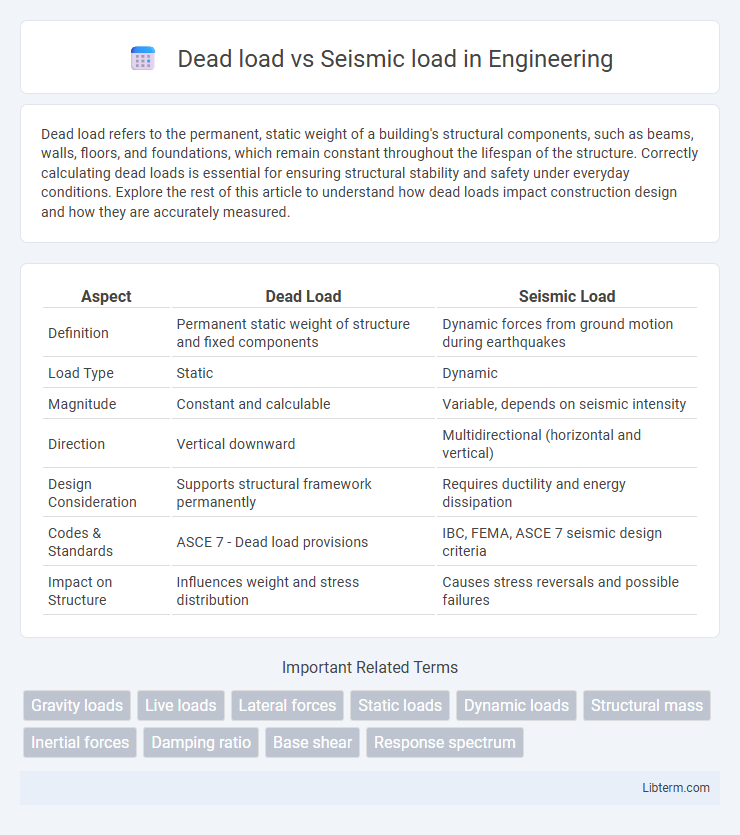Dead load refers to the permanent, static weight of a building's structural components, such as beams, walls, floors, and foundations, which remain constant throughout the lifespan of the structure. Correctly calculating dead loads is essential for ensuring structural stability and safety under everyday conditions. Explore the rest of this article to understand how dead loads impact construction design and how they are accurately measured.
Table of Comparison
| Aspect | Dead Load | Seismic Load |
|---|---|---|
| Definition | Permanent static weight of structure and fixed components | Dynamic forces from ground motion during earthquakes |
| Load Type | Static | Dynamic |
| Magnitude | Constant and calculable | Variable, depends on seismic intensity |
| Direction | Vertical downward | Multidirectional (horizontal and vertical) |
| Design Consideration | Supports structural framework permanently | Requires ductility and energy dissipation |
| Codes & Standards | ASCE 7 - Dead load provisions | IBC, FEMA, ASCE 7 seismic design criteria |
| Impact on Structure | Influences weight and stress distribution | Causes stress reversals and possible failures |
Introduction to Structural Loads
Dead load refers to the permanent, static forces acting on a structure due to its own weight and fixed components such as walls, floors, and roofs. Seismic load represents dynamic forces generated by earthquake ground motions, causing inertial effects that vary in magnitude and direction over time. Understanding the distinction between these structural loads is critical for designing buildings that ensure stability, safety, and resilience under both constant and transient stress conditions.
Understanding Dead Loads
Dead loads refer to the permanent, static forces exerted by the weight of a building's structural components such as beams, columns, floors, and walls. These loads are predictable and remain constant throughout the structure's lifespan, providing a baseline for structural design and safety analysis. Understanding dead loads is crucial for ensuring that the building can support its own weight before considering dynamic forces like seismic loads.
Defining Seismic Loads
Seismic loads refer to the forces exerted on a structure during an earthquake, caused by the ground motion and inertia of the building's mass. Unlike dead loads, which are static and constant, seismic loads are dynamic and vary in intensity and direction over time. These loads are crucial for seismic design, as they determine the structural resilience needed to withstand earthquake-induced stresses.
Fundamental Differences Between Dead and Seismic Loads
Dead load refers to the permanent, static weight of a structure, including materials like concrete, steel, and fixtures that remain constant throughout the building's lifespan. Seismic load involves dynamic forces generated by earthquake-induced ground movements, resulting in lateral and vertical stresses that fluctuate rapidly over time. The fundamental difference lies in dead load being constant and predictable, while seismic load is variable, time-dependent, and requires complex analysis for structural resilience against seismic events.
Sources and Characteristics of Dead Loads
Dead loads primarily originate from the permanent structural elements of a building, including beams, columns, floors, walls, and fixed equipment, contributing to a consistently applied static force. These loads are characterized by their constant magnitude, predictable distribution, and slow variation over time, providing a stable baseline for structural design. In contrast to seismic loads, which are dynamic and transient forces induced by earthquake ground motions, dead loads remain unaffected by external environmental events.
Causes and Dynamics of Seismic Loads
Dead loads are static forces due to the weight of a structure's permanent components such as walls, floors, and roofs, while seismic loads arise from ground motions caused by tectonic plate shifts and earthquakes. Seismic loads generate dynamic forces that vary with time, velocity, and acceleration, resulting in lateral and vertical vibrations impacting the structural integrity. The intensity and duration of seismic loads depend on earthquake magnitude, distance from the epicenter, local soil conditions, and building resonance characteristics.
Impact of Dead and Seismic Loads on Building Design
Dead load represents the permanent, static weight of a structure including walls, floors, and fixed equipment, which determines the foundational strength and structural support requirements. Seismic load accounts for dynamic forces generated by earthquakes, necessitating flexible design strategies to absorb and dissipate energy, reducing risk of structural failure. The impact on building design involves balancing rigidity for dead loads with ductility for seismic resilience, ensuring both stability and safety under varying load conditions.
Load Calculation Methods and Standards
Dead load calculation methods rely on fixed structural components' weights using standardized density values per building material, following guidelines set by ASCE 7 and Eurocode EN 1991. Seismic load estimation incorporates dynamic response factors based on ground motion parameters, site classifications, and building importance, adhering to seismic design criteria in codes like IBC, ASCE 7-16 Chapter 11, and Eurocode EN 1998. Both load types require precise quantification for structural safety, with seismic load calculations emphasizing time-history or equivalent static analysis to accommodate seismic risk variability.
Structural Safety: Balancing Dead and Seismic Loads
Dead load refers to the fixed weight of a structure's components such as beams, walls, and floors, which remain constant over time, while seismic load involves dynamic forces generated by ground motion during an earthquake. Structural safety requires careful balancing of these loads to ensure stability and prevent failure; engineers design frameworks to resist seismic forces without compromising the integrity under dead load conditions. Advanced materials and seismic dampers contribute to mitigating risk, optimizing load distribution, and enhancing a building's resilience against earthquakes alongside its inherent dead weight support.
Conclusion: Importance of Load Assessment in Construction
Accurate assessment of dead loads and seismic loads is crucial for ensuring structural safety and stability in construction projects. Dead loads represent the permanent static forces from building materials, while seismic loads involve dynamic forces caused by earthquakes, requiring distinct engineering considerations. Proper evaluation and integration of both load types into design protocols prevent structural failures and enhance resilience against natural hazards.
Dead load Infographic

 libterm.com
libterm.com